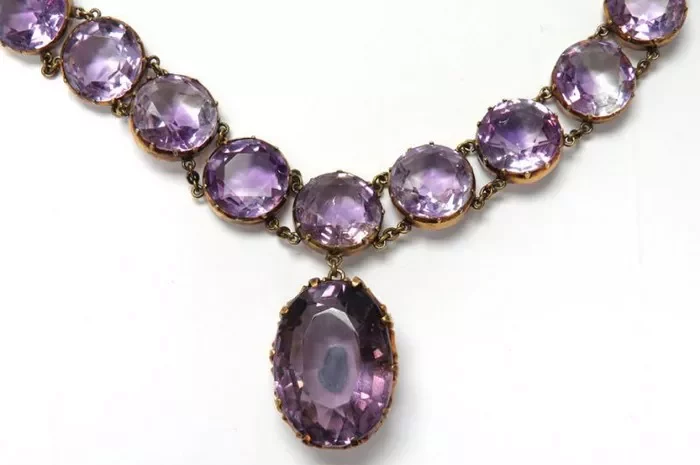Amethyst, this mysterious and elegant gemstone, is deeply loved by people for its unique purple gloss and rich symbolic meanings. As a member of the jewelry world, amethyst is not only sought after for its beautiful appearance but also highly regarded for its potential energy and benefits. However, many people have doubts about whether amethyst can be worn every day. This article will provide a detailed professional interpretation of the daily wearing safety of amethyst to help everyone better understand this gemstone.
Basic Characteristics of Amethyst
Amethyst, a member of the quartz family, is primarily composed of silicon dioxide. Its color ranges from light purple to deep purple, and some may even have white or black stripes, forming unique textures and patterns. With a moderate hardness of 7 on the Mohs scale, amethyst is suitable for being processed into various types of jewelry, such as necklaces, bracelets, and rings.
In addition to its beautiful appearance, amethyst is also believed to have various benefits. It is considered a stone of wisdom, capable of enhancing memory and improving mental sharpness. At the same time, amethyst is also thought to have the ability to ward off evil and provide protection, bringing good luck and peace. Furthermore, amethyst is believed to stabilize emotions, relieve stress, and help people maintain inner calm and tranquility.
Daily Wearing Safety of Amethyst
The question of whether amethyst can be worn every day mainly depends on the quality of the gemstone and the personal situation of the wearer.
Safety of Natural Amethyst
Natural amethyst, due to its natural formation and pure composition, generally does not pose any harm to the wearer. However, it should be noted that natural amethyst may contain tiny cracks or inclusions during its formation. These imperfections may expand under external forces during wearing, leading to the gemstone’s cracking or damage. Therefore, when wearing natural amethyst, it is necessary to avoid violent collisions and friction to prevent damaging the gemstone.
In addition, natural amethyst may lose its luster over time due to contamination from sweat, oil, and other substances. Therefore, it is recommended to regularly clean the amethyst with clear water and wipe it clean with a soft cloth to maintain its luster and beauty.
Safety of Synthetic Amethyst
Compared to natural amethyst, synthetic amethyst may differ in composition and structure. Some unscrupulous merchants may use radiation dyeing or harmful materials to enhance the color vividness or reduce costs. These harmful substances may pose risks to the human body when worn for a long time.
Therefore, when purchasing synthetic amethyst, it is essential to choose reputable merchants through formal channels. At the same time, carefully examine the gemstone’s dyeing condition and component description to ensure that the purchased amethyst is safe and harmless.
Personal Situation of the Wearer
Apart from the quality of the amethyst, the personal situation of the wearer is also an important factor affecting the safety of wearing amethyst. For some individuals, due to differences in constitution or allergies, wearing certain gemstones may cause skin discomfort or allergic reactions.
Therefore, before wearing amethyst, it is recommended to try it on sensitive areas such as the wrist to observe for any allergic reactions. If symptoms such as redness, itching, or discomfort occur, wearing should be immediately stopped, and professional medical advice should be sought.
Maintenance and Precautions for Amethyst
To ensure the safety of wearing amethyst, apart from choosing good-quality gemstones, the following maintenance and precautions also need to be taken into consideration:
Avoid Collisions: Although amethyst has moderate hardness, it still needs to avoid violent collisions and friction. During wearing, try to avoid contact with other hard objects to prevent damaging the gemstone.
Avoid High Temperatures: Amethyst may undergo color changes or cracking in high-temperature environments. Therefore, avoid exposing amethyst to direct sunlight or high-temperature environments.
Avoid Chemicals: Amethyst is afraid of alkaline substances, so it should be avoided from coming into contact with chemicals such as soap and shampoo. It is recommended to remove amethyst when bathing or doing housework.
Regular Cleaning: To maintain the luster and beauty of amethyst, it is recommended to regularly clean the gemstone with clear water and wipe it clean with a soft cloth.
Proper Storage: When not wearing amethyst, store it in a dry, cool place, and avoid mixing it with other jewelry to prevent scratching or damage.
Conclusion
In summary, amethyst, as a beautiful and mysterious gemstone, has daily wearing safety that mainly depends on the quality of the gemstone and the personal situation of the wearer. When choosing amethyst, one should select gemstones of good quality and pure composition, and pay attention to maintenance and precautions during wearing. At the same time, for some individuals, due to differences in constitution or allergies, it may be necessary to wear amethyst with caution. By making reasonable choices and taking proper care, we can better enjoy the beauty and mystery that amethyst brings.
Related topic:
- The Charms of Amethyst and Fluorite
- The Mystical Charm of Amethyst and Black Obsidian
- What is Amethyst Used for in Jewelry?


